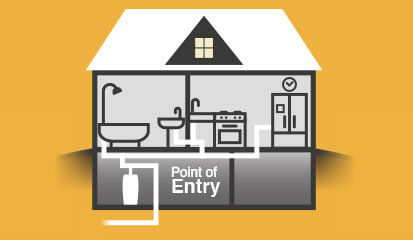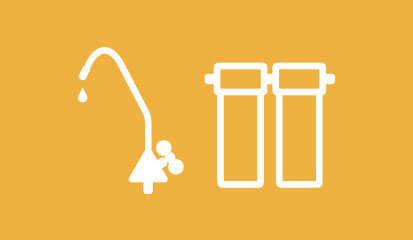Contaminants & Filtration Systems FAQ
Do these systems reduce lead?
What is water filtration?
Where does my water come from?
What’s the difference between Chlorine and Chloramines? Are these bad for me?
How do I know what’s in my water?
What system is best for me?
It depends on your specific water. Things to consider when picking the right system for you and your family are:
- What are your water issues – scale, dirt and particles, cloudiness, taste, concerns about safety
- Where you want filtered water – whole home, kitchen sink, dedicated filtered water faucet, refrigerator, ice maker, RV or boat
- What you want removed from your water – rust, sand, chlorine taste and odor, specific contaminants such as lead, nitrates, bacteria, viruses, pharmaceuticals
- Your water source – city water or private well
- Your budget – Whirlpool® offers a range of solutions to meet every budget
Take our quiz to help you determine your best option.
If I have a water softener do I need a water filtration system?
There is a difference between water softeners and water filtration systems, and the necessity of one or the other—or both—is based on your home’s water needs.
Water softeners are designed to soften hard water by replacing calcium and magnesium with sodium. Water filtration systems can remove a wide range of contaminants such as sodium, lead, cysts, VOCs, chemicals, bacteria, and viruses providing safer, cleaner, better-tasting water for drinking and cooking. Depending on the source of your water and your particular concerns, a water filtration system may be right for you.
Whirlpool offers a range of Water Filtration Systems to meet your needs. If you have a water softener the UtlraEase™ Reverse Osmosis Filtration System is a good way to remove the sodium added to your water from your water softener.
Where should I filter my water – Point of Use or Point of Entry?
Point of use filtration, which includes undersink, refrigerator, end of faucet and pitcher filtration systems, provides water for making beverages and ice, adding to recipes, and filling up your pet’s water bowl. Point of use filtration systems can remove a range of contaminants including chlorine taste and odor, microbial cysts such as giardia, volatile organic compounds (VOCs) such as benzene and acetone, heavy metals such as lead, industrial pollutants such as asbestos, bacteria, virus and pharmaceuticals. There are a range of systems to meet your safety concerns and budget.
Point of Entry filtration, also known as Whole Home Filtration, is installed where the main water line enters your home providing filtered water throughout your home. This type of filtration removes particulates such as rust, sand, silt and sediment providing cleaner, clearer water to protect your plumbing and appliances. A good indicator of the amount of sediment in your water supply is the toilet tank. Examine the tank for debris.
Consumers choose the level of the filtration that is best for them through their filter choice. Whole Home filters have a micron rating based on how much and what type of particulates they remove from the water. Carbon filters are available to remove chlorine taste and odor in addition to sediment. Whirlpool offers a line of Premium Carbon Whole Home Water filters made from patented FACT® media – a new sub-micron filter technology – that delivers cleaner, better-tasting water without the flow reduction and they last twice as long compared to other whole home filters. Consumers on private wells tend to need a whole home water filtration system.
Depending on your water issues, safety concerns and taste preferences, you may want multiple filtration systems in your home. It is not unusual to have a Point of Entry system to clean the water as it enters your home and Point of Use systems in the kitchen and bathroom to remove contaminants before your family consumes it.
Why can only certain contaminants – such as lead and bacteria – be removed with a Point of Use system?
Can I install my Whirlpool® Water Filtration System myself?
Do I need an extra faucet for my undersink filtration system?
Do I have to drill a hole in my sink and countertop for an extra faucet for my undersink filtration system?
What is a dissolved solid?
Solid materials that decompose in water are called dissolved solids. These solids enter the water supply from various sources and include substances like minerals, sodium, arsenic, copper, nitrates, radium and more. Installing a Reverse Osmosis (RO) system reduces dissolved solids in your water. Water softeners add sodium to your water when softening. The Whirlpool UltraEase™ Reverse Osmosis Filtration System is a good way to remove the sodium added to your water from your water softener.
What is reverse osmosis (RO) and why would I want an RO system in my home?
Reverse osmosis is a common process that removes dissolved solids from water. After passing through a pre-filter to remove chlorine and sediment, water is forced through the reverse osmosis membrane. The membrane only allows water molecules to pass through. Processed water flows to a storage tank while the remaining water with the contaminants is flushed down a drain. A dedicated faucet at your sink, when turned on, activates the system, pulling water from the storage tank through a carbon post filter to improve taste and remove any odors.
Reverse osmosis is the same process used by producers of high-quality bottled water. Having a system installed at your kitchen sink allows you to get great-tasting, filtered water in your own home, for a fraction of the cost of bottled water.
One thing to note is that you will notice the sound of water draining and running after each time you use your system. This is completely normal — the system is filtering and refilling clean water to your tank. Part of that process also includes rinsing out the membrane which is used to filter your water. Rest assured that these sounds are a sign of a fully functional reverse osmosis system.
Why should I change my Whirlpool® Water Filtration System filters every 6 months? My water looks and tastes fine.
Many harmful contaminants are undetectable – tasteless, colorless and odorless. Just like any type of container, filters have a capacity. Once that capacity is reached, the filters may not be able to remove the contaminants from your water. Extensive testing and design has been incorporated into your Whirlpool® Water filtration system to ensure your safety. Ensure your system is doing what you bought it for – providing great-tasting, cleaner, safer water for your family – replace your filters every 6 months.
What is sediment filtration?
Sediment filtration reduces particulates such as dirt, rust sand, and silt from water. Consumers with well water are more prone to having water with high levels of sediment. A point-of-entry or whole home water filtration system is recommended for sediment issues. This removes the particulates from your water as it enters your home, protecting your plumbing and appliances as well as eliminating sediment from your toilet bowl, sinks and bathtub. A good indicator of the amount of sediment in your water supply is the toilet tank. Examine the tank for debris. Point-of-use remove smaller particulates for cleaner, clearer drinking water and ice for drinking and cooking.
What is a micron rating? Is lower or higher better?
A micron is a unit of measurement that is equal to one thousandth of a millimeter. Micron ratings are used in water filtration to refer to the size of particulates, such as sand, silt and sediment that a filter can remove from your water. Filters with a higher micron rating remove larger particles and those with a lower micron rating take out smaller particles in addition to larger particles. The desirable rating – higher or lower – depends on your water and how often you want to change your filters. If you don’t have a lot of sand and sediment, a sub-micron or lower micron rating will remove more particles from your water providing you cleaner water. If you have high amounts of sand and sediment, a sub-micron or lower micron level will clog up quicker and need to be changed more often. We recommend trying a few filters with different micron ratings to determine which works best with your water and desired filter change schedule.
Can I install a filtration system to both my kitchen sink and refrigerator water lines?
Yes. A single system can be used to supply a faucet at your kitchen sink and to your refrigerator’s water line. This is a great way to save money on expensive refrigerator filters. Be sure to use your refrigerator’s bypass plug if it has an internal filtration system.
Do you make filtration systems for boats, RVs, campers and motorhomes?
Yes. The Whirlpool In-Line Refrigerator Filtration System can be used with any sink, refrigerator or ice maker with an external water line. So it is an ideal product for boats, RVs, campers, and motorhomes.
Where are Whirlpool® Water Filtration Systems built?
Whirlpool® Water Filtration Systems are built in Iuka, Mississippi.
Do I need an electricity source?
For Whirlpool Undersink Filtration Systems you do not need an electricity source. Undersink water filtration systems are powered by water pressure. But, if your water source is a private well, your water pump will need power to pressure your water.
The Whirlpool Central Filtration system works on 28V DC electrical power supplied by a direct plug-in power supply (included) that needs to be plugged into a 120V, 60Hz household outlet in a dry location.


